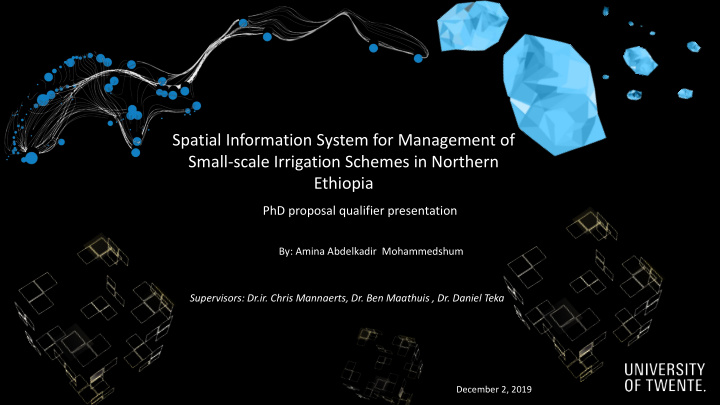



Spatial Information System for Management of Small-scale Irrigation Schemes in Northern Ethiopia PhD proposal qualifier presentation By: Amina Abdelkadir Mohammedshum Supervisors: Dr.ir. Chris Mannaerts, Dr. Ben Maathuis , Dr. Daniel Teka December 2, 2019
Content ▪ Introduction ▪ Objectives ▪ Standardized Spatiotemporal Information for Research approach Irrigation Management of Small-scale Irrigation Schemes ▪ Case study ▪ Expected outputs 2
Introduction Rainfed-agriculture is the main production system in the study area, However ▪ Due to moisture stress, production is limited to rainy season ▪ The production and productivity through this system is very low In order to tackle this challenge, the regional government has introduced several irrigation schemes 3
Continued ▪ Irrigation is vital for realizing full potential of agricultural sector ▪ Efficient utilization of water resources ▪ Sustainable economic growth and poverty reduction ▪ Required in many arid and semi-arid areas during periods of insufficient rainfall 4
Continued The Ministry of Water Resources Irrigation and Electricity (MoWIE) ▪ Irrigation development is classified based on the size of the command area: ▪ Small-scale (less than 200 hectares (ha)), ▪ Medium-scale (200 ha to 3000 ha) and ▪ Large-scale is greater than 3000 ha 5
Problem analysis 6
Gaps ▪ Inadequate knowledge on water use efficiency ▪ Lack of integration and coordination ▪ Advisory system lacks crop water requirements ▪ No standardized information system to monitor the existing irrigation schemes ▪ Irrigation water efficiencies are not well documented ▪ Lack of integrated assessment of small-scale irrigation schemes 7
Objectives The proposed research project is to improve the planning and managements of water use efficiency and agricultural water productivity in small-scale irrigation schemes. Objective 1 Classify irrigation schemes using remote-sensing based indices Develop a spatial monitoring and information system for small- scale irrigation Objective 4 areas 8
Research approach Research workflow Objective 1 Model irrigation management system in order to improve food security Develop a system Develop an For irrigation irrigation on-a- planning and stick of spatial monitoring information Objective 4 system 9
Research approach Objective 1: Characterize small-scale irrigation schemes based on socio-economic, technical, and institutional aspects What are the socio-economic impacts of irrigation on livelihood of farmers? Evaluate irrigation performance using technical parameters Evaluate irrigation performance using institutional assessment What is the (technical) efficiency in use of water and water productivity in parameters irrigation schemes in the study area? What is the efficiency and effectiveness of local institutions in the planning and monitoring of an irrigation scheme? 10
Research approach Objective 1 Methodology 11
Research approach Objective 2: Classify irrigation schemes using remote-sensing-based indices in order to facilitate feature extraction for mapping ▪ How to map different types of small-scale irrigation schemes using remote sensing and derived products? ▪ How to map small-scale irrigated areas at different scale? 12
Research approach Objective 2 Methodology 13
Research approach In-situ/Farmers Objective 3: Evaluate irrigation scheme performances using the Triple sensor approach Model RS ▪ How can water use efficiency and crop productivity using the Triple sensor approach be monitored? ▪ What is the agricultural water productivity of the irrigation scheme at Zamra catchment? ▪ How to improve the assessment of irrigation productivity at Zamra catchment? 14
Research approach Objective 3 Methodology 15
Research approach Objective 4 What type of information should be provided at different scales and users? Develop a spatial Develop an irrigation on-a-stick monitoring and What should be the characteristics of an information operational irrigation spatial information system for system? small-scale How will the IrSpIS improve the irrigation irrigation system performances? 16
Research approach Objective 4 Methodology 17
Research approach Objective 4 Different spatial and temporal scales information to different users Methodology High (30m) Low (250m) Scale Medium (100m) Irrigation scheme Irrigated field Zamra catchment Spatial scale Monthly and seasonal 3-10 days Seasonal Temporal scale • What to produce • • Amount of water in the reservoir Total irrigated area • When and how much irrigate • • Irrigated area Crop water productivity Information • • Crop water productivity Weather forecast • Water Use Association • • Woreda irrigation experts Development Agents Users • Landuse planners • Regional irrigation experts 18
Case study This study will be conducted in Northern Ethiopia Tekeze watershed, specifically in the Zamra catchment • Area is approximately 3492km 2 19
Expected outputs ▪ Integrated assessment of small-scale irrigation schemes ▪ Mapping small-scale irrigated areas ▪ Monitoring of irrigation schemes water use efficiency and water productivity ▪ Develop a spatial monitoring and information system for small-scale irrigation ▪ To support irrigation managers towards improving water use efficiency and agricultural water productivity ▪ Two MSc student theses will be included ▪ GTPII is to increase food production of irrigated lands by expansion of irrigation schemes and rehabilitating existing ones ▪ Special emphasis on food security, water use efficiency and sustaining the environment 20
Time table Years I II III IV (Nov 2018- Dec2019) (Jan2019- Dec 2020) (Jan 2021- Dec 2021) (Jan 2022- Dec 2022) Activity Q1 Q2 Q3 Q4 Q1 Q2 Q3 Q4 Q1 Q2 Q3 Q4 Q1 Q2 Q3 Q4 Literature review Qualifier Fieldwork Objective 1 Activity 1 Activity 2 Activity 3 Objective 2 Activity 1 Activity 2 Activity 3 Objective 3 Activity 1 Activity 2 Activity 3 Objective 4 Activity 1 Activity 2 Activity 3 Activity 4 Final thesis Progress reports Defense Objective 1 Q: Quarter Objective 2 Objective 3 Objective 4 21
Thank you
Recommend
More recommend